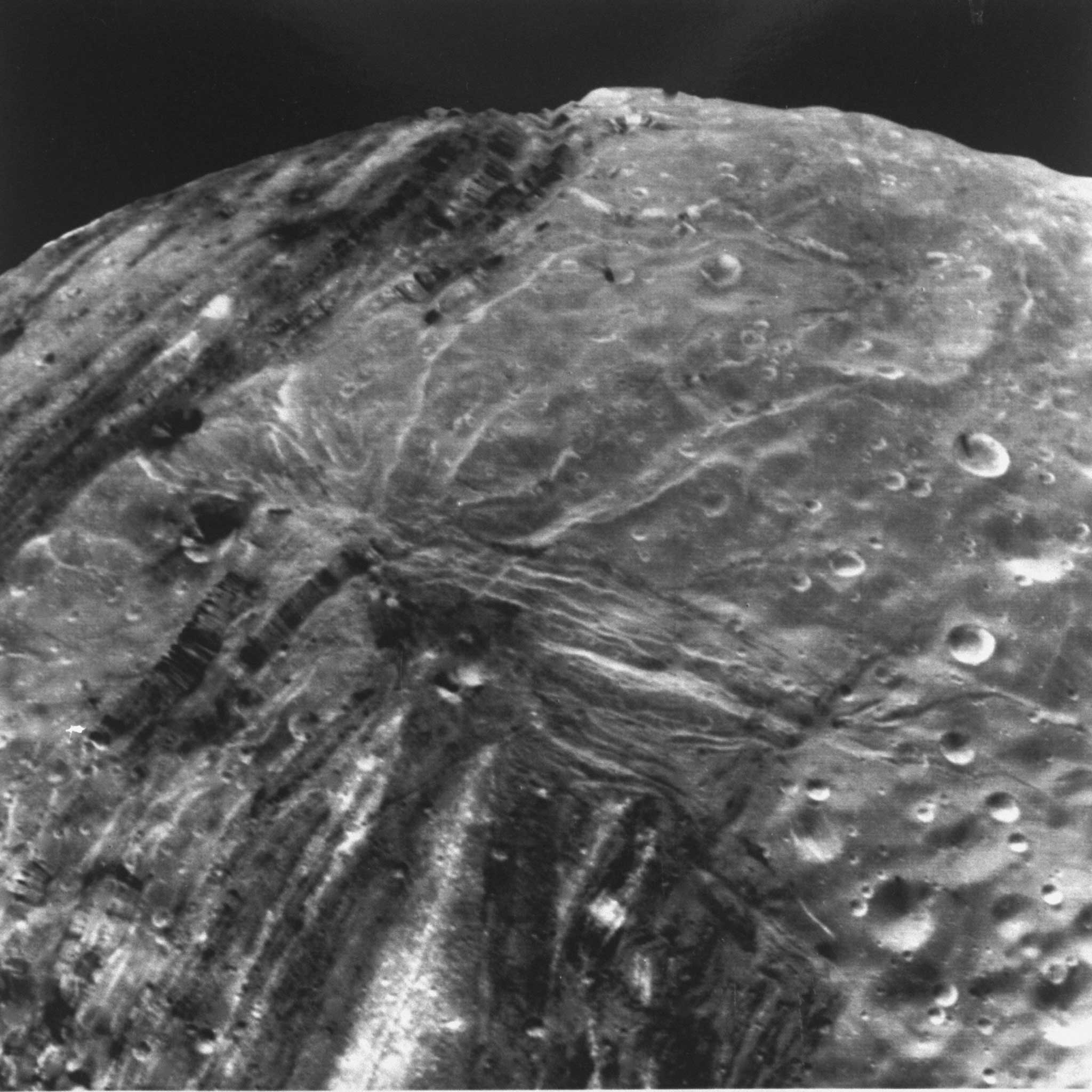
The first and only space probe ever to visit the planet Uranus timed its encounter very badly from a public-relations perspective. Voyager 2 zipped past the solar system’s seventh planet on Jan. 24, 1986; four days later, the shuttle Challenger exploded in flames. And suddenly, far-off Uranus and its retinue of moons didn’t seem so important anymore.
Yet the images Voyager took during that overshadowed encounter have continued to intrigue planetary scientists ever since — and that’s especially true when it comes to Miranda, one of the planet’s five main moons. Its surface, U.S. Geological Survey astrogeologist Laurence Soderblom told TIME shortly after the encounter, “is a bizarre hybrid,” while NASA describes Miranda as having “one of the strangest and most varied landscapes among extraterrestrial bodies.”
Perhaps the strangest features of all are Miranda’s three visible “coronae” — relatively crater-free regions marked by ridges and valleys and slapped onto the surface “like mismatched patches on a moth-eaten coat,” in NASA’s words. But now, nearly three decades after they were found, Miranda’s coronae may have an explanation at last. Writing in the journal Geology, Brown University planetary scientists Noah Hammond and Amy Barr argue that these odd scraps of terrain come from ancient hot spots in the moon’s 100-mile-thick crust of ice. “Despite being incredible cold,” says Hammond, ” there’s a lot of geologic activity on this moon.”
Geology on the frigid moons of the outer solar system itself isn’t such big news these days. Scientists have spotted volcanoes on Jupiter’s moon Io, ice geysers on Saturn’s moon Enceladus, lakes on Titan, plate tectonics on Europa and more. But to have geology, you need some source of heat, and there just doesn’t seem to be one for Miranda, which is deep-frozen to about –350°F.
There’s no heat source now, anyway. But Miranda’s orbit is unusually tilted with respect to Uranus’ equator — its “inclination,” as astronomers call it, is about 10 times greater than that of the planet’s other major moons. One way that could have come about is if Miranda’s orbit was originally very eccentric, or elongated. That would have brought it into close encounters with other moons, which could have relocated into a tilted orbit.
If Miranda’s orbit really was elongated, the moon would have been squeezed and stretched by the tidal effect of Uranus’ gravity, and, just like a rubber ball squeezed in your hand, it would have heated up a bit. And that rising heat would have made the ice itself flow very, very slowly upward — a process physicists call convection. Hammond and Barr created a computer model of that flow, and sure enough, he says, “we were able to show that if shell is convecting, it naturally produces four upwellings.” Since it’s just a model, it can’t simulate the actual moon precisely, but it’s definitely in the ballpark of what Voyager saw.
Each upwelling of ice would have tried to spread as it reached the surface, and crinkled, accordion-fashion, into the ridges and valleys that characterize the coronae. The fact that these regions are relatively crater-free fits right in: new ice flowing out from the interior would have to sit on the surface for a long time to match the cratering of the surrounding areas.
The coronae can’t be more than a few hundred million years old — peanuts compared with the rest of the surface, which dates back billions of years, and consistent, Hammond says, with the fact that Miranda probably gained its tilt and lost its heat generation about that long ago.
It all hangs together — but since it’s based on a handful of images taken nearly 29 years ago that only show Miranda’s southern hemisphere, it may be hard to be proved definitively. Planetary scientists have a far richer set of observations for the moons of Jupiter and Saturn, where the Galileo and Cassini probes respectively stuck around snapping photos for years rather than flying by (and Cassini is still going strong).
Unfortunately, while scientists are contemplating return missions to Jupiter and Saturn, nobody’s got plans to revisit Uranus. Which leaves Hammond and Barr’s theory of where the coronae came from in the “convincing but not definitive” realm.
Hammond is absolutely definitive about one thing, however. “Miranda,” he says, “is a really cool moon.”
More Must-Reads From TIME
- The 100 Most Influential People of 2024
- Coco Gauff Is Playing for Herself Now
- Scenes From Pro-Palestinian Encampments Across U.S. Universities
- 6 Compliments That Land Every Time
- If You're Dating Right Now , You're Brave: Column
- The AI That Could Heal a Divided Internet
- Fallout Is a Brilliant Model for the Future of Video Game Adaptations
- Want Weekly Recs on What to Watch, Read, and More? Sign Up for Worth Your Time
Contact us at letters@time.com